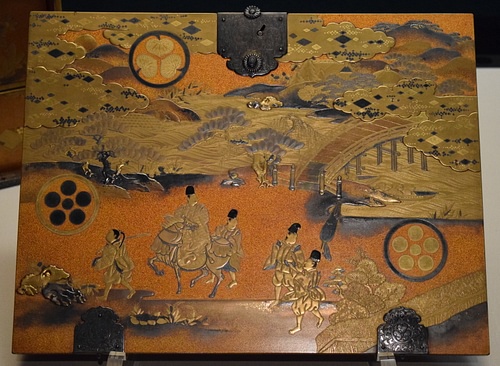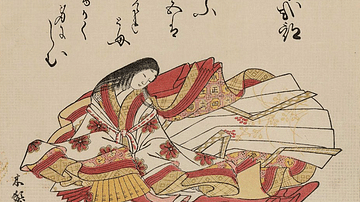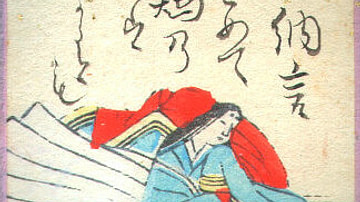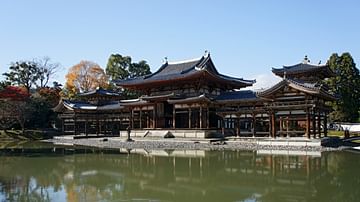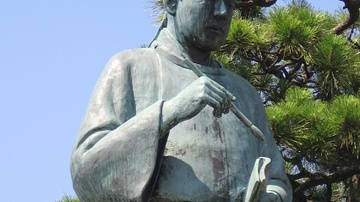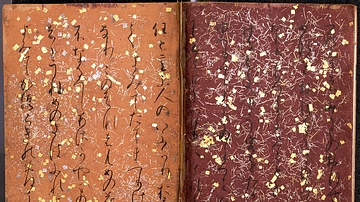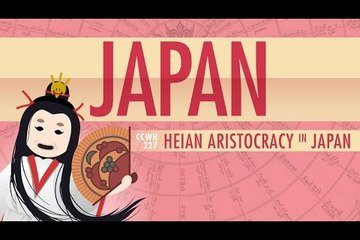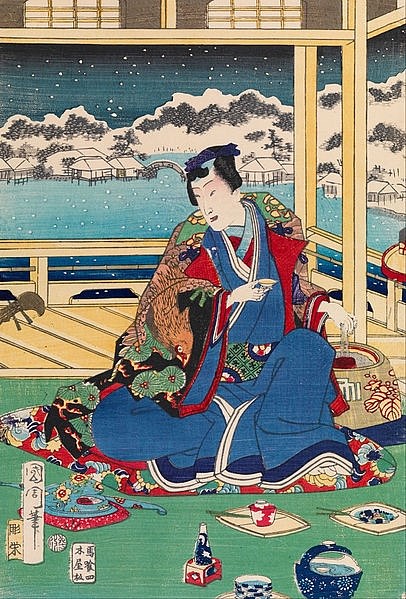
The 'Tale of the Genji' or Genji Monogatari, written in the 11th century CE by Murasaki Shikibu, a court lady, is Japan's oldest novel and possibly the first novel in world literature. The classic of Japanese literature, the work describes the life and loves of Prince Genji and is noted for its rich characterisation and vivid descriptions of life in the Japanese imperial court. The work famously reproduces the line 'the sadness of things' over 1,000 times and has been tremendously influential on Japanese literature and thinking ever since it was written. The 'Tale of Genji' continues to be retranslated into modern Japanese on a regular basis so that its grip on the nation's imagination shows no sign of loosening.
Murasaki Shikibu
The work's author is considered to be a lady of the imperial court by the name of Murasaki Shikibu who wrote it over several years and completed it around 1020 CE during the Heian period (794-1185 CE). Murasaki is also known as To no Shikibu. Murasaki was a nickname and shikibu means 'secretariat,' which was the role of her father as in ancient Japan it was common to call a daughter by her father's position. She was a member of the Fujiwara clan. Her birth is accepted as around 973 CE and her death after 1013 CE, the date of the last mention of her in court documents. Details of her life are sketchy except that her father was Fujiwara no Tametoki, a provincial governor, and that she married a fellow Fujiwara clan member, one Fujiwara no Nobutaka, with whom she had one daughter, Daini no Sammi. Murasaki's husband died in 1001 CE, and she then became a lady-in-waiting (nyobo) to Empress Akiko (aka Shoshi) where she displayed great talent in the arts, particularly calligraphy, the harp (koto), painting, and poetry. Besides the novel, other surviving works by Murasaki include poems and her diary.
Genji Monogatari
The Japanese title Genji Monogatari may be translated as 'The Tale of Prince Genji.' It consists of 54 chapters and 750,000 words, although the final 13 chapters are regarded as a later addition by a minority of scholars principally because the story then no longer concerns Genji but his son Kaoru and takes on a darker tone. Neither do scholars entirely agree on the order of the chapters as many seem like later insertions by the author and several are parallel chapters or narabi where events occur not after but contemporary with the events described in earlier 'ordinary' chapters (hon no maki).
The novel describes life in the Japanese imperial court, its etiquette and intrigues, and, above all, the central character of Prince Genji who is the perfect gentleman in looks and deed. Genji's relations, love affairs, and transition from youth to middle age are all captured by Murasaki's astute writing which combines romanticism and realism in equal measure to capture a timeless treatment of human relations and the general impermanence of all things. The following summary highlights the Genji Monogatari's contribution to world literature:
Earlier "novels" had too closely resembled fairy tales, or else were realistic but had no feeling for the complexity and capacity for development of their characters. Murasaki Shikibu's book, though imaginative fiction, is both descriptively and psychologically true to life. It deals with society as it was and people as they were. This remarkable woman had independently developed the novel as a true literary form. (Mason, 96)
In her own words Murasaki describes this discovery:
But I have a theory of my own about what this art of the novel is...it happens because the storyteller's own experience of men and things, whether for good or ill - not only what he has passed through himself, but even events which he has only witnessed or been told of - has moved him to an emotion so passionate that he can no longer keep it shut up in his heart. Again and again something in his own life or that around him will seem to the writer so important that he cannot bear to let it pass into oblivion. (Mason, 96)
The book is written in a notoriously complex style with frequent poetic ambiguity and over 800 inserted poems, but it was an instant success and quickly gained its reputation as a timeless classic. It has been read, studied, alluded to, quoted extensively, and imitated in countless subsequent Japanese literary works and theatre ever since. Beautiful editions were made with painted illustrations besides the calligraphy, an art, of course, in itself. Indeed, the oldest scroll paintings (onnae) from Japan, and some would say the finest, are 19 illustrations (each 21.8 cms high) from an abridged edition of the Genji Monagatari believed to have been painted in the 1120s or 1130s CE.
The Tale of Genji: A Summary
Part 1
The 'Tale of Genji' covers the lifetime of Prince Genji and then his descendants, which is a period of some 70 years. The story is set at the height of the Heian period during the reign of Emperor Daigo, 897-930 CE. Prince Hikaru Genji is the son of an emperor but not in direct line to the throne. Although Genji is a fictional character there was a similar figure with a similar story in the imperial court, one Minamoto no Takaakira, the tenth son of Emperor Daigo, and he would have been known both to Murasaki and her readers.
We begin with the birth of Genji and are informed that his mother, Kiritsubo, has a low status at court and is mistreated by the emperor's other wives. Kiritsubo dies when Genji is only three. An expert in divination from Korea predicts that if ever Genji acquires the throne the state will suffer a disaster. Kokiden, consort of the emperor, is also a jealous enemy of Genji. The emperor responds to the prophecy by making the prince a commoner with the surname Minamoto or Genji. However, the emperor loves Genji very much and permits him to reside in the royal palace.
The emperor then finds a woman, Fujitsubo, who closely resembles Kiritsubo, and invites her to court to be his first consort. A real beauty, Genji falls desperately in love with his stepmother but, aged 12, he marries Aoi, six years his senior. Bewitched by Fujitsubo, Genji's marriage is a failure. He has numerous affairs, most significantly with a lowly girl called Murasaki who resembles Fujitsubo and who he will later marry. Genji has two sons, one with Aoi, called Yugiri, and another with his stepmother, who, recognised as the emperor's own, will become the future Emperor Reizei. Genji is ashamed of his affair with Fujitsubo, but when Reizei discovers his true father, he gives Genji the great honour of a rank equal to that of a retired emperor. This is recompense for Genji's earlier exile to Suma (where he whiled away the time in an affair with the Lady of Akashi, the former governor's daughter).
Genji & Lady Rokujo: "At last the night ended in such a dawn as seemed to have been fashioned for their especial delight. 'Sad is any parting at the red of dawn; but never since the world began, gleamed day so tragically in the autumn sky', and as he recited these verses, aghast to leave her, he stood hesitating and laid her hand tenderly in his." (Keene, 499)
Part 2
Emperor Suzaku, now retired, asks Genji to marry his third daughter as he is concerned for her future well-being. Genji, whose first wife Aoi died in childbirth thanks to the evil wishes of a former lover Lady Rokujo, consents to the request, but the girl is also the niece of Fujitsubo. Genji's other wife Murasaki is jealous despite Genji's explanation for his actions and repetition of his feelings for her, his true love. Nevertheless, Murasaki expresses a wish to become a nun but first falls ill and dies. Meanwhile, the princess has an affair with Kashiwagi, the son of Genji's best friend To no Chujo. Genji is then forced to accept into his family the child which results from this illicit liaison, Kaoru.
Part 3
The final part of the book, comprising 10 chapters often called the Uji chapters (the location of this part of the story), is set after the death of Genji and relates the problems and intrigues which beset his descendants, in particular, Kaoru his son and Niou, Genji's grandson. Both of these men, after dallying with two princesses, Oigimi and Nakanokimi, fall in love with the same woman, Ukifune, half-sister to the princesses. Both male characters pale in comparison to the superlative character of Genji. Ukifune, caught in an impossible situation, attempts suicide but fails and becomes a nun, refusing to see her former lovers. There the tale ends.
This content was made possible with generous support from the Great Britain Sasakawa Foundation.
